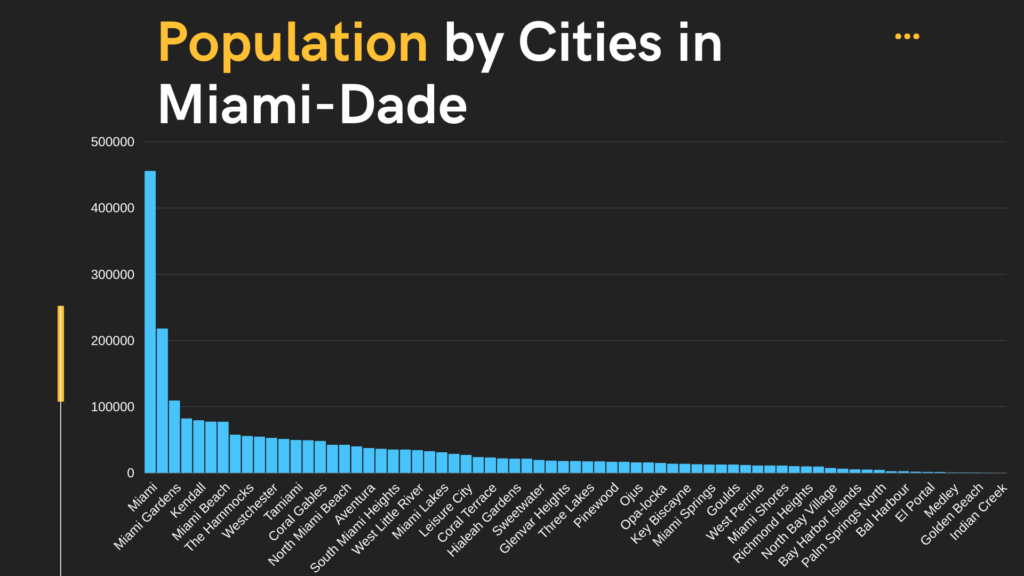Miami, known for its vibrant culture, stunning beaches, and bustling nightlife, is a city that draws people from all over the world. The population of Miami reflects its diverse and dynamic nature, with a rich tapestry of nationalities and ethnicities. In this article, we will explore the population statistics of Miami, breaking down the numbers by region, nationality, and other interesting facts.
Population Breakdown by Region
Miami is part of Miami-Dade County, the most populous county in Florida. As of 2024, Miami-Dade County has an estimated population of approximately 2.8 million people. The city of Miami itself is home to around 470,000 residents. Below is a breakdown of the population by cities in Miami-Dade.

Nationalities and Ethnic Composition
Miami is renowned for its cultural diversity, primarily influenced by its large Hispanic and Latino population. Here are some key statistics regarding the ethnic composition of Miami:
- Hispanic or Latino: 70% of Miami’s population
- Cuban: 34%
- Puerto Rican: 4%
- Mexican: 3%
- Other Hispanic or Latino: 29%
- White (Non-Hispanic): 12%
- Black or African American: 16%
- Asian: 1.5%
- Other Races: 0.5%
Languages Spoken
Given its diverse population, Miami is a multilingual city. Spanish is the most commonly spoken language, followed by English. Here’s a breakdown of languages spoken at home:
- Spanish: 64%
- English: 29%
- Other Languages: 7%
Age Distribution
Miami’s population is diverse not only in terms of nationality but also in age. The age distribution is as follows:
- Under 18 years: 22%
- 18 to 24 years: 9%
- 25 to 44 years: 29%
- 45 to 64 years: 26%
- 65 years and over: 14%
Economic Facts and Employment
Miami’s economy is diverse, with key industries including tourism, international trade, finance, and healthcare. The median household income in Miami-Dade County is approximately $53,000. Here are some employment statistics:
- Labor Force Participation Rate: 64%
- Unemployment Rate: 3.7%
- Major Industries:
- Tourism and Hospitality: 15%
- Finance and Real Estate: 12%
- Healthcare and Social Assistance: 18%
- International Trade: 10%
Education Levels
Education levels in Miami are varied, reflecting the diverse population. Here’s a snapshot of educational attainment:
- High School Graduate or Higher: 82%
- Bachelor’s Degree or Higher: 28%
Interesting Facts and Statistics
- International Population: Over 51% of Miami’s population is foreign-born, making it one of the most international cities in the United States.
- Tourism Impact: Miami attracts over 16 million tourists annually, significantly boosting the local economy.
- Cultural Festivals: Miami hosts numerous cultural festivals, such as the Calle Ocho Festival, Miami International Film Festival, and Art Basel Miami Beach, celebrating its rich cultural heritage.
- Real Estate Market: Miami’s real estate market is robust, with a median home value of approximately $375,000, and the new construction market with prices starting at $360,000.
Conclusion
Miami’s population is a vibrant mosaic of cultures, nationalities, and languages. Its unique demographic makeup contributes to the city’s rich cultural tapestry and dynamic atmosphere. Whether it’s the influence of the large Cuban community, the blend of languages spoken, or the diverse age distribution, Miami stands out as a truly cosmopolitan city.
This blend of cultural diversity, economic vitality, and educational opportunities makes Miami not only a fascinating place to visit but also a dynamic place to live.


